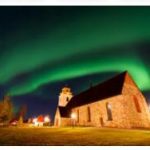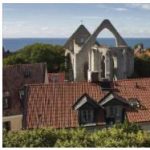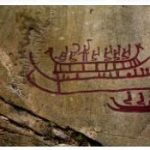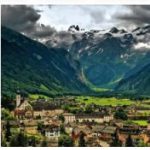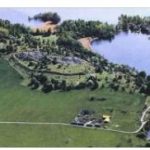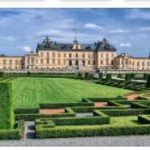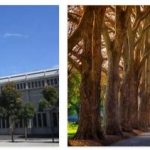The Stockholm Forest Cemetery was laid out between 1917 and 1920 by architects Gunnar Asplund and Sigurd Lewerentz. In it, the natural landscape, park design and architecture merge.
Skogskyrkogården cemetery near Stockholm: facts
| Official title: | Skogskyrkogården (cemetery) near Stockholm |
| Cultural monument: | between 1917 and 1940 a forest cemetery was set up in 85 hectares (later increased to 108 hectares), former gravel pits overgrown with coniferous trees; the landscape – hills, terraces, valleys, clearings – determines the design of the »grove of the dead« |
| Continent: | Europe |
| Country: | Sweden |
| Location: | Stockholm |
| Appointment: | 1994 |
| Meaning: | as a forest cemetery, a harmonious combination of landscape and architecture with an impact on modern cemetery design in numerous countries |
Skogskyrkogården cemetery near Stockholm: history
| 1914 | Erik Gunnar Asplund and Sigurd Lewerentz Prize winners for the design of the cemetery |
| 1920 | Forest chapel based on a design by Asplund |
| 1923-32 | Unemployed Stockholmers build a granite cemetery wall |
| 1925 | Inauguration of the Resurrection Chapel (design by Lewerentz) |
| 1937-40 | Crematorium with the chapels of Hope, the Holy Cross and Faith based on plans by Asplund |
| 1940 | Asplund is buried next to the faith chapel |
In the middle of the green a place of eternity
At the beginning, the visitor is led through an open landscape area via a semicircular, classically pure forecourt: silence and peace prevail. The view falls on a tree-lined hill, a very large, free-standing cross and a hall building to which a wall leads – unexpected, considering the name of the cemetery, but the forest is within reach everywhere.
The eternal resting place goes back to an international tender from which the young architects Erik Gunnar Asplund and Sigurd Lewerentz emerged as the winners. The two were to create a cemetery out of coniferous forest and gravel pits, which was to be characterized by dignity, artistic quality and harmony of the buildings as well as the landscape and vegetation. For Asplund and Lewerentz, the filigree architecture was not the starting point, but the pre-Nordic and medieval burial grounds. The largest part of the cemetery consists of high-growing northern coniferous forest, which is criss-crossed by straight paths, next to which the grave sections are located. The elegant fountain basins in the cemetery, reminiscent of Roman art, bear witness to the fact that no detail is too small or unimportant. The gravel pits were expanded into terraces with graves or laid out as an anterior-northern burial mounds. In this way, the natural characteristics of the terrain were emphasized.
It took almost three decades for the cemetery to find its final shape. The Asplund forest chapel is in the central part of the cemetery, in the middle of a wooded area. There the forest looks as if it came from a painting by Caspar David Friedrich, the romantic landscape painter of the transition period from the 18th to the 19th century. According to Asplund, his chapel should »(…) be subordinate to the forest in a very modest way. Pine and fir trees rise above the roofs up to twice the height of the building. A forest path leads directly to the vestibule, which is supported by twelve pillars and in which the funeral procession gathers. The iron-clad gates are opened and you can see the bright room of the chapel through the inner lattice gate. ”The interior of the chapel, which is covered with black clapboards, is whitewashed.
Five years after the forest chapel, the Resurrection Chapel was built by Sigurd Lewerentz, which, like the forest chapel, takes on the topic of “Care for the vulnerable situation of the mourners”. It is located in a grove at the end of the “Path of the Seven Fountains”. The gate is clad with copper and the handle is shaped like a rope that has become stiff. The base of the handle sits in a circle, the keyhole in an isosceles triangle. The peephole in the gate is square – circle, triangle and square: the eternity of the divine, the mystery of the Trinity and Christ’s incarnation.
According to cheeroutdoor, the forest crematorium, consisting of three grave chapels with an associated crematorium, completed the design of the forest cemetery. Here Asplund repeats: “The chapel must be designed around its real meaning, around the difficult moment of parting.”
Even the walk from the entrance to the cemetery, along the wall and up the long slope, does not resemble a normal walk through cemeteries. One would rather think of treading a cobbled Roman path like the Via Appia. Apart from the large stone cross, there are no Christian symbols. The traditional threats of the punishment of sinners as well as the promises of redemption are replaced by the message of the landscape – of its transience and its eternity. The inside of the crematorium is exactly the same. Here the difference between believers and other participants is dissolved. Nobody has priority in his room and nobody can be excluded. The hour of parting is presented to everyone and everyone. One of the first to be blessed here was Gunnar Asplund himself.



